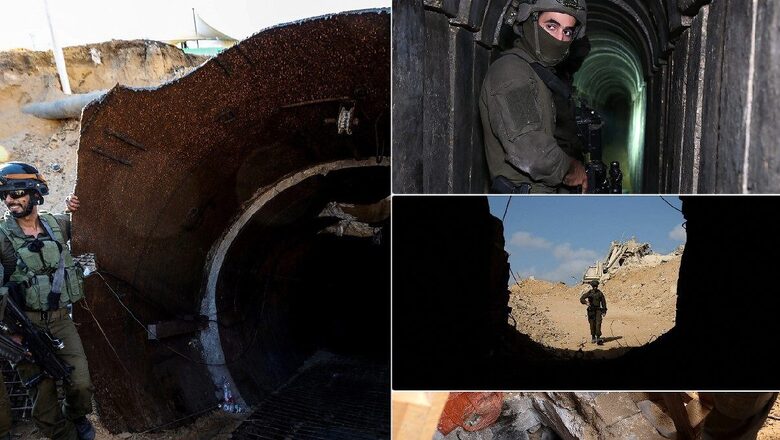
views
When Israel imposed a crippling blockade on the Gaza Strip in 2007, smugglers built a network of tunnels on the border with Egypt, enabling them to import everything from essential household goods to cars and even Kentucky Fried Chicken — as well as weapons and alcohol.
In the years that followed, the ‘Gaza Metro’ – a nickname given by Israeli soldiers for the subterranean city that Hamas built – was fortified, to wage a war, capture hostages and ensure the survival of Hamas, the Strip’s leadership.
Hamas leader Yahya Sinwar in a speech six months before October 7 appeared to brag of the militant group’s capabilities and threatened Israel of ‘waves of attacks’.
Sinwar’s Threats
“We will come to you, God willing, in a roaring flood. We will come to you with endless rockets, we will come to you in a limitless flood of soldiers, we will come to you with millions of our people, like the repeating tides,” Sinwar warned Israelis at a rally for his supporters in Gaza on December 2022, which was dismissed as empty boasts, a report by the Washington Post said.
Roughly a year later, a US counter-terrorism official, on tour of the tunnels at the invitation of the Israeli Defence Forces (IDF), said their (he and his hosts’) ‘eyes were bulging’.
“They had no idea of the labyrinth. Can you image 150 kilometers of tunnels? The reality
was several times bigger,” the official told the Washington Post.
Following the October 7 attacks Hamas knew that the Israeli response would be brutal and inevitable but knew that its tunnel system would ensure its survival for at least a year, the report further added.
‘Hats Off’
Dan Goldfus, the major general now dubbed as IDF’s tunnel destroyer, admitted that when he ‘understood’ what he encountered in the form of the tunnels, he said: ‘Hats off!’
Hamas has diverted hundreds of millions of dollars intended for humanitarian and economic projects in Gaza, instead channeling these funds into constructing an extensive tunnel network. As of October 7, this underground infrastructure stretched over roughly 500 kilometres, surpassing the length of the New York City subway system, and running roughly the distance between southern Turkey and Tel Aviv, observers say, all beneath a strip of land that is exactly the same land area as Las Vegas and more tightly packed than New York City.
Despite their efforts, the Israel Defense Forces (IDF) admit that it is virtually impossible to completely dismantle the entire tunnel system.
But Goldfus and his crew say that they owe their success in countering Hamas’s tunnel warfare not to a single breakthrough or moment of insight but to meticulous planning and sustained dedication.
At first, Goldfus and other generals were cautious, refraining from sending full units into the Hamas tunnels.
Even by January, three months into the war, soldiers rarely entered the tunnel system despite having already invaded Khan Yunis.
It wasn’t until later that Goldfus recognized that Hamas’s tunnels weren’t isolated structures but rather part of a vast, decentralized network.
‘Survive, Regroup’
This realization came after he and his advisors identified key patterns after which they understood that Hamas did not just intend to engage in underground combat, but also used its tunnel system as a means to survive, rest, and regroup, according to a report by the Jerusalem Post.
A large weapons manufacturing hub was discovered in the tunnels which was a complex of underground workshops and street-level warehouses, uncovered by IDF forces in January beneath a densely populated district in Khan Younis, Gaza. These workshops, linked by tunnels, formed an extensive weapons assembly line spanning nearly half a mile, according to an IDF weapons expert who analyzed the site.
Goldfus acknowledged that the IDF would not be able to reach and destroy every tunnel in the Hamas network. Instead, his focus was on eliminating a critical mass of the tunnels—those that posed the greatest threat to Israel due to their strategic proximity. This approach prioritized targeting the most dangerous sections of the tunnel system.
The IDF says recovering the bodies of the 12 hostsges that were recovered from the tunnels was a success because of Goldfus.
The group’s estimated 5,700 tunnel shafts have been destroyed by Israeli bombs.
‘Everything Connected’
“We succeeded in making manufacturing factories underground, because we knew that one day all the
channels would be closed” Ghazi Hamad, a member of Hamas’s political bureau from Gaza, was quoted as saying as the Washington Post.
“We prepared a lot, not for one year or two years. In Gaza we were working day and night, day and night, 24 hours,” he further added.
Hamas’ tunnels were not merely places were abductees were held, those tunnels served as a communications network, supply depot, highway system, logistics pipeline, bomb shelter and
field hospital, according to Israeli, Arab and American intelligence officials.
“All our definitions of tunnel shafts, tactical tunnels, strategic tunnels — none of that applies there, it’s all one large network; you can enter it at the [northern] Erez Crossing and emerge in Rafah [on the Egyptian border]. Everything there is connected to everything” Goldfus was quoted as saying by the Hebrew-language newspaper Israel Hayom in August.




















Comments
0 comment